If you’re looking to infuse your home with a touch of tranquility and style, Japanese bedroom aesthetics might just be the answer. This guide offers ten fresh ideas to help you create a serene, minimalist space that embraces natural elements and traditional design. From selecting the right color palette to incorporating essential furniture, let’s explore how to transform your bedroom into a peaceful retreat inspired by Japanese culture.
Sliding Shoji Doors
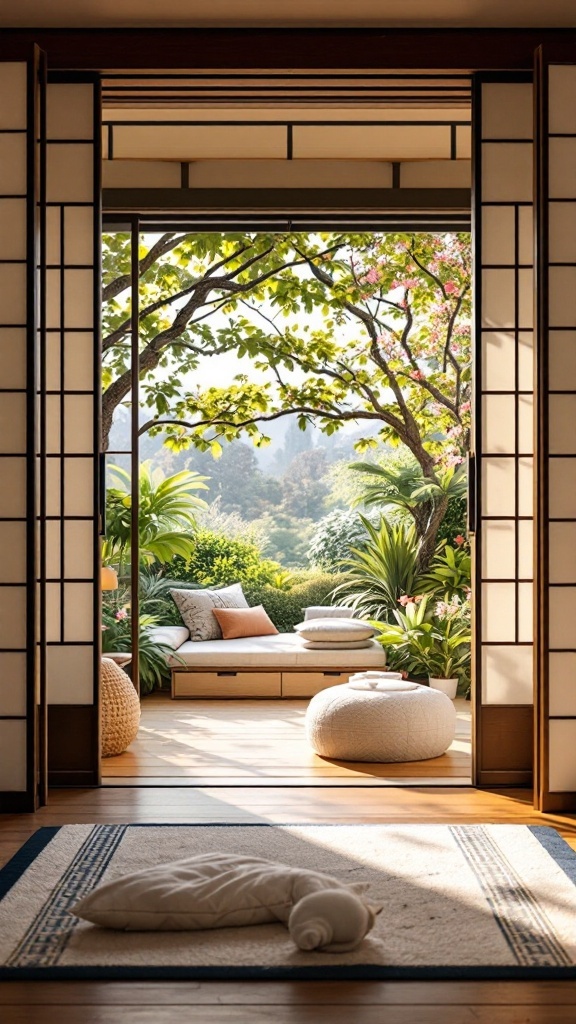
Sliding shoji doors are a hallmark of Japanese design, combining elegance and practicality. These doors are made from a wooden frame and translucent paper, allowing soft light to filter through while maintaining privacy.
In the image, the shoji doors perfectly frame a serene outdoor space filled with lush greenery. This design choice not only connects the inside to nature but also brings a calming effect to the bedroom.
The sliding mechanism saves space, making it easy to open up your room without swinging doors intruding into the area. This is especially important in smaller bedrooms where every inch counts.
Additionally, these doors enhance the overall aesthetic of a Japanese-style bedroom. The simple lines and natural materials create a peaceful atmosphere, inviting relaxation and tranquility.
Nature-Inspired Elements
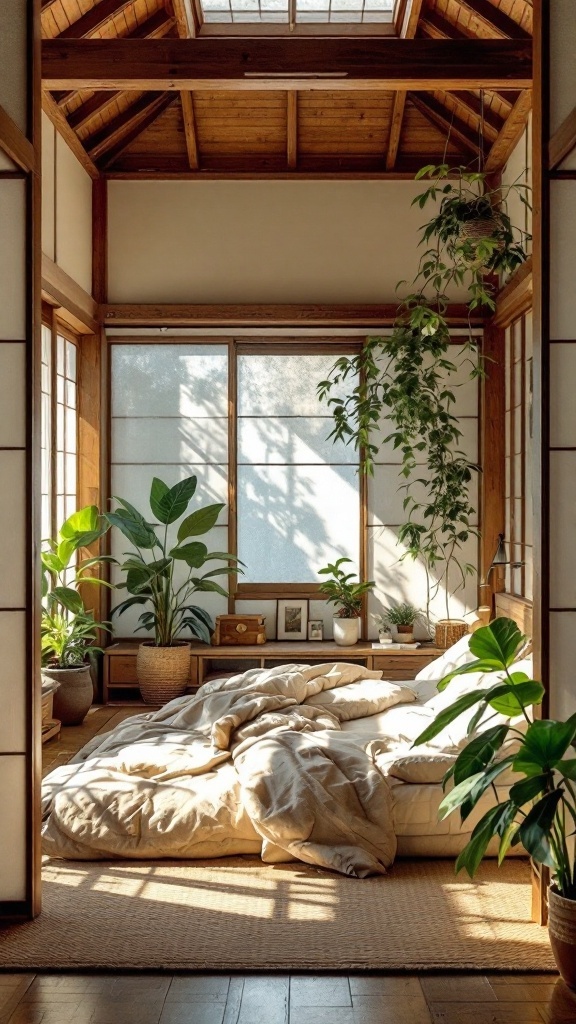
A bedroom that embraces nature is all about creating a peaceful atmosphere. This image shows a bright, airy space filled with greenery that instantly feels refreshing. The large windows let in natural light, enhancing the warm tones of the wooden beams and flooring.
The use of plants is a key aspect of Japanese-style bedrooms. Here, lush greenery adds life and vibrancy to the room. These plants not only beautify the space but also improve air quality, promoting a calming environment.
The bedding is soft and inviting, complementing the natural elements around. A light, neutral palette helps to maintain a serene vibe, making it easy to unwind after a long day. Incorporating natural textures, like the woven rug, brings an earthy feel that ties everything together.
Think about how you can introduce similar nature-inspired elements into your bedroom. A few well-placed plants, natural materials, and plenty of light can transform your space into a relaxing retreat that mirrors the harmony found in nature.
Minimalist Zen Sanctuary
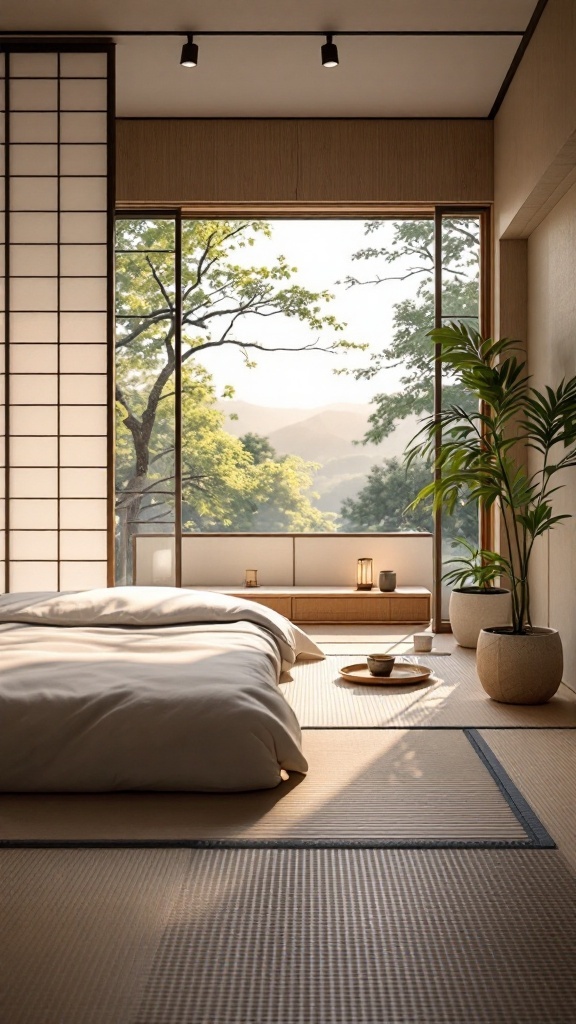
In a minimalist Zen sanctuary, simplicity is key. The bedroom features soft, neutral colors that create a calm atmosphere. The bed is low to the ground, enhancing the sense of tranquility and connection to the earth.
The large windows invite natural light, showcasing a beautiful view of greenery outside. This connection with nature is central to the Zen philosophy, allowing you to feel refreshed as you wake up each morning.
Decor is minimal yet thoughtfully chosen. A few plants bring life and freshness to the space without overwhelming it. The tatami mat flooring adds warmth and texture, making the room feel cozy yet spacious.
Consider incorporating natural materials like wood and stone to further enhance the serene vibe. These elements help create a peaceful environment, allowing you to unwind and relax after a long day.
Futon on Tatami
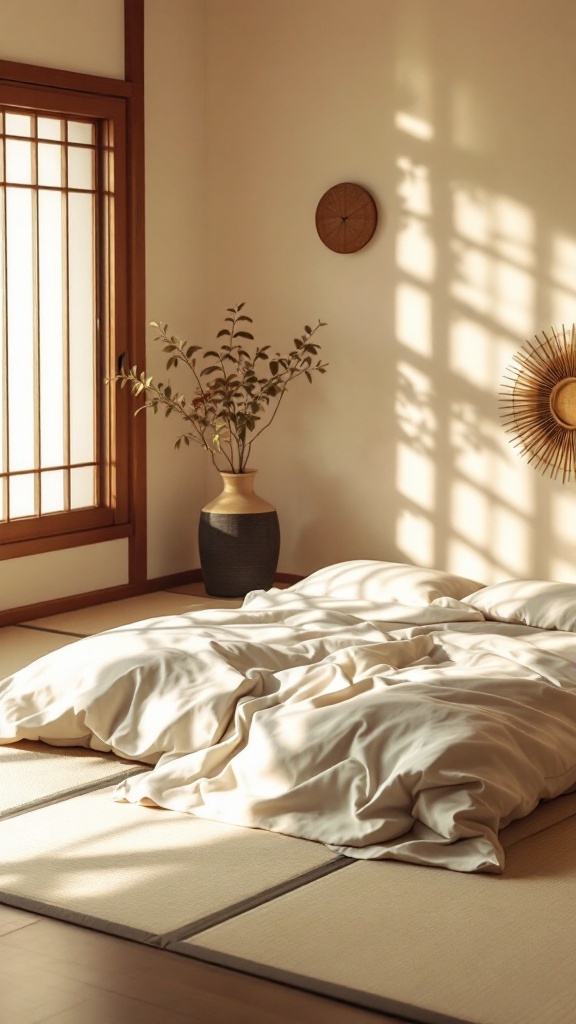
Embracing the simplicity of Japanese design, a futon on tatami provides a cozy sleeping arrangement that is both traditional and inviting. Tatami mats, made from rice straw and covered with a woven rush, create a natural and earthy foundation for your bedroom.
The image shows a serene space where gentle sunlight filters through traditional sliding doors, casting lovely shadows on the floor. The soft, unmade futon invites you to relax and unwind after a long day. Adding touches like a vase with greenery and simple wall decor enhances the peaceful atmosphere.
This setup not only emphasizes comfort but also aligns with the minimalist aesthetic that many people find appealing today. By choosing a futon, you can easily fold it away during the day, making your room feel more spacious. This flexibility allows for more room to move around, keeping your space tidy and functional.
Warm Lighting Atmosphere
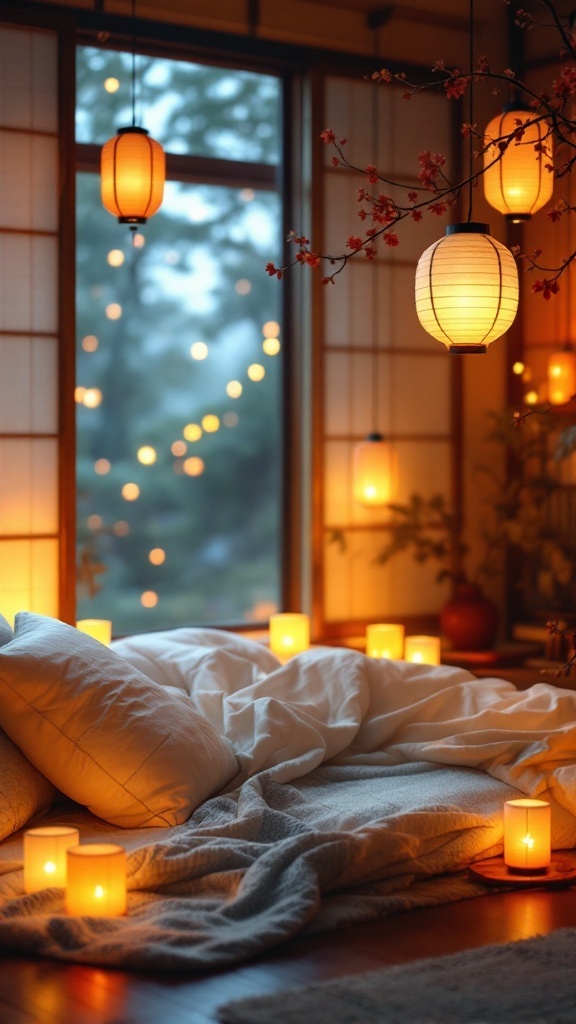
The cozy vibe of a Japanese style bedroom often comes from its warm lighting. This image beautifully captures that atmosphere with soft, glowing lanterns and candlelight. These light sources create a serene and inviting space, perfect for relaxation.
The combination of hanging lanterns and scattered candles not only enhances the room’s aesthetic but also plays a crucial role in setting the mood. Soft, diffused light can make a room feel more spacious and calming, ideal for unwinding after a long day.
Incorporating natural elements, such as the cherry blossom branches seen here, adds to the warmth. It connects the indoor space with the beauty of nature, a key aspect of Japanese decor that promotes tranquility. Layering soft textiles like blankets and pillows accentuates the cozy feeling, making it a perfect retreat.
Tatami Mat Designs
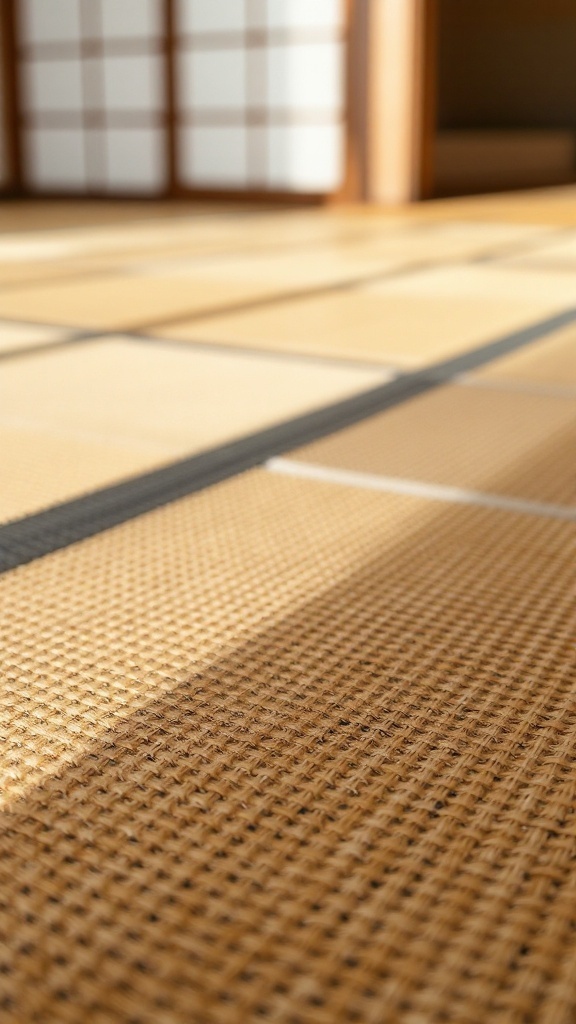
Tatami mats are a key element in traditional Japanese bedrooms. They add a unique texture and warmth to the space. The image beautifully showcases the intricate weave of the tatami mats, highlighting their natural straw material. These mats not only provide comfort but also maintain a sense of tranquility in the room.
The simplicity of tatami designs allows for versatile decor options. You can easily match them with wooden furniture, low tables, and futons. This creates an inviting atmosphere perfect for relaxation. Plus, tatami mats are known for their moisture-wicking properties, making them practical for various climates.
When designing your bedroom, consider using tatami mats in different layouts. For instance, you can create a pattern or use them in a single color for a more minimalist look. This flexibility lets you personalize your space while embracing Japanese aesthetics.
Low Profile Furniture

Low profile furniture is a key element in achieving a Japanese style bedroom. This design approach emphasizes simplicity and minimalism. In the image, you can see a cozy bed with a low frame, inviting you to relax without overwhelming the space.
The light beige tones throughout the room create a soothing atmosphere. The bedding complements the low-profile aesthetic, promoting a calm environment. The small wooden side tables add practicality without taking up much visual space, enhancing the room’s balance.
Incorporating plants, like the graceful foliage in the corner, brings a touch of nature indoors. This connection to the outside world is important in Japanese design, creating a serene and harmonious vibe. Simplicity is key, allowing each piece of furniture to stand out while contributing to the overall feel.
When choosing low profile furniture, think about materials that resonate with nature. Wood is a popular choice, as seen in the tables. It adds warmth and texture to the room, making it feel inviting. Overall, low profile furniture plays a crucial role in creating a peaceful Japanese style bedroom.
Traditional Décor Accents
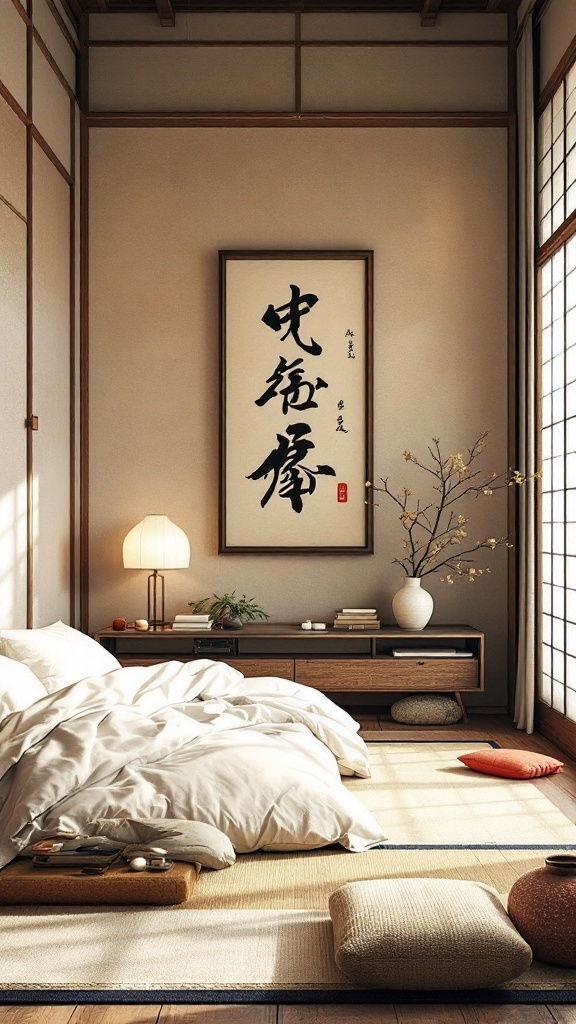
Creating a Japanese-style bedroom often means embracing simplicity and elegance. The image showcases a serene space that perfectly embodies traditional Japanese décor. Notice the warm, neutral tones of the walls, which create a calming atmosphere.
The artwork is a significant focal point. Calligraphy not only reflects Japanese culture but also adds a personal touch to the space. It can inspire tranquility and mindfulness, making it a perfect accent for your bedroom.
Natural elements play a crucial role in this design. The delicate branch in the vase brings a bit of nature indoors, which is essential in Japanese aesthetics. Incorporating plants or flowers can enhance the peaceful vibe of your room.
Another striking feature is the low furniture, including the tatami mat and cushions. This layout invites comfort and relaxation, making it easy to unwind after a long day. Plus, the soft bedding adds warmth and coziness, perfect for restful nights.
Overall, traditional décor accents like these create a harmonious space that promotes relaxation and well-being. With careful selection of colors, materials, and art, you can easily transform your bedroom into a Japanese oasis.
Outdoor Connection with Shoji Windows
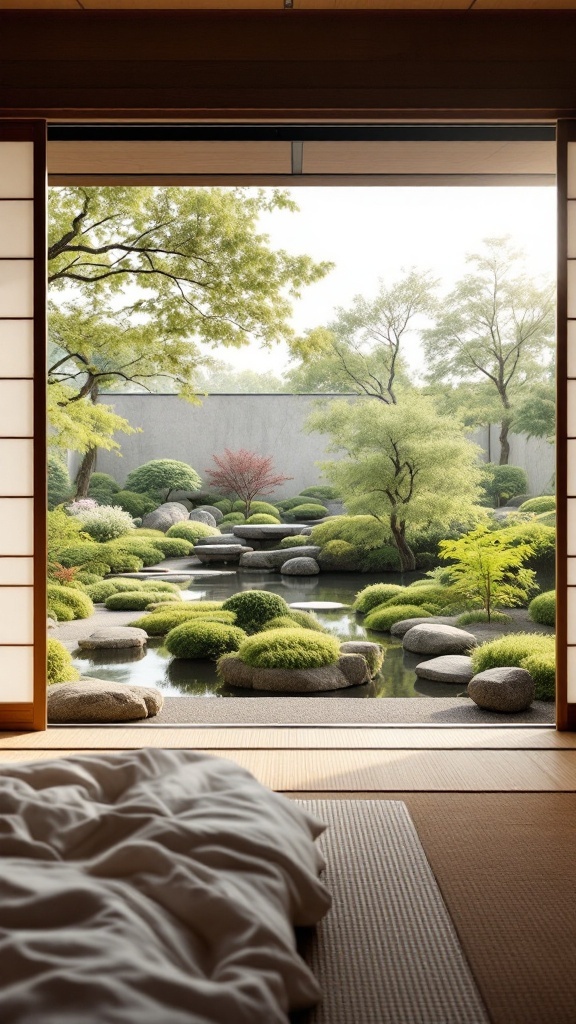
Shoji windows are a beautiful feature in Japanese-style bedrooms, creating a seamless connection between indoor and outdoor spaces. They are typically made of wooden frames with translucent paper, allowing soft light to filter through while maintaining privacy.
The image captures a serene view of a carefully landscaped garden through these windows. You can see lush greenery, smooth stones, and a tranquil pond, all of which enhance the calming atmosphere of the room. This natural scenery invites a sense of peace and helps bring the outside in.
Having Shoji windows can also encourage a lifestyle that values nature. It creates a perfect spot for morning meditation or evening relaxation. Their design complements traditional tatami mats and bedding, making the space feel open yet cozy.
Imagine waking up to this view every day! The garden’s vibrant colors change with the seasons, offering a dynamic backdrop that enriches the overall bedroom experience. Whether it’s spring blossoms or autumn leaves, you’ll always have a little piece of nature right at your fingertips.
Meditative Reading Nook
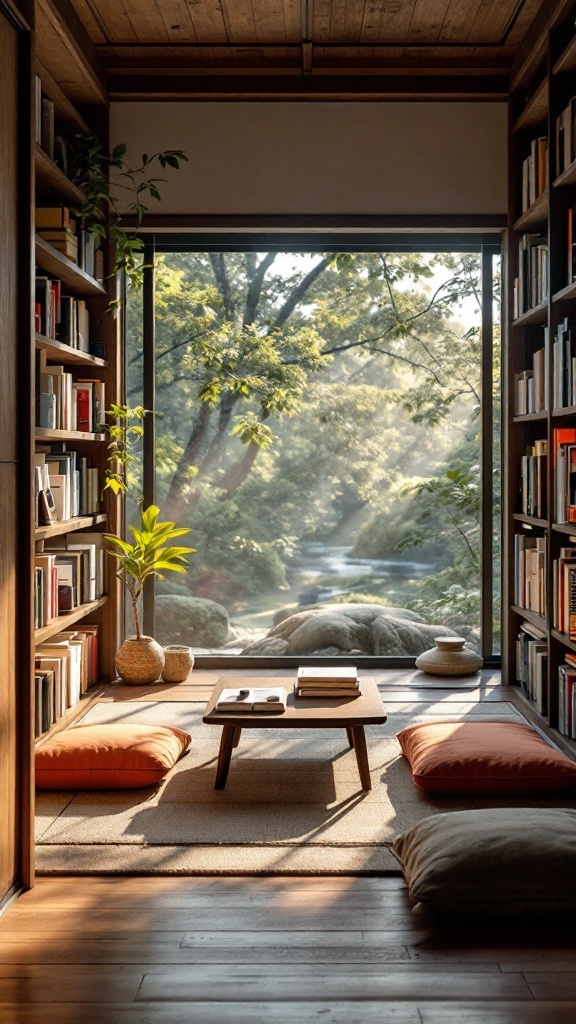
Creating a meditative reading nook in your Japanese-style bedroom can transform your space into a personal sanctuary. This cozy corner is designed for relaxation and reflection, perfect for diving into a good book while surrounded by nature.
The image showcases a serene area with soft cushions on the floor, inviting you to sit back and unwind. A low wooden table holds a few books, making it easy to pick one up for a peaceful reading session. The warm wooden tones and natural light streaming through the large window create a calming atmosphere.
Plants add a touch of life, connecting your indoor space to the outdoors. The view of the lush greenery outside enhances the feeling of tranquility, making it an ideal spot for both reading and meditative practices. You can enjoy the sounds of nature while losing yourself in the pages of a book.
To create your own meditative nook, consider adding a similar low table and comfortable seating options like cushions or tatami mats. A well-placed window or a view of your garden can make all the difference. Remember, it’s all about creating a peaceful environment where you can relax and reflect.









